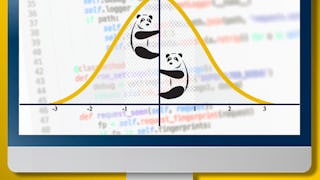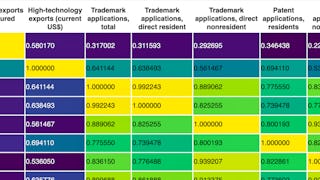In this course, we will explore basic principles behind using data for estimation and for assessing theories. We will analyze both categorical data and quantitative data, starting with one population techniques and expanding to handle comparisons of two populations. We will learn how to construct confidence intervals. We will also use sample data to assess whether or not a theory about the value of a parameter is consistent with the data. A major focus will be on interpreting inferential results appropriately.

Enjoy unlimited growth with a year of Coursera Plus for $199 (regularly $399). Save now.

Inferential Statistical Analysis with Python
This course is part of Statistics with Python Specialization



Instructors: Brenda Gunderson
48,171 already enrolled
Included with
(932 reviews)
Recommended experience
What you'll learn
Determine assumptions needed to calculate confidence intervals for their respective population parameters.
Create confidence intervals in Python and interpret the results.
Review how inferential procedures are applied and interpreted step by step when analyzing real data.
Run hypothesis tests in Python and interpret the results.
Skills you'll gain
Details to know

Add to your LinkedIn profile
See how employees at top companies are mastering in-demand skills

Build your subject-matter expertise
- Learn new concepts from industry experts
- Gain a foundational understanding of a subject or tool
- Develop job-relevant skills with hands-on projects
- Earn a shareable career certificate

There are 4 modules in this course
In this first week, we’ll review the course syllabus and discover the various concepts and objectives to be mastered in weeks to come. You’ll be introduced to inference methods and some of the research questions we’ll discuss in the course, as well as an overall framework for making decisions using data, considerations for how you make those decisions, and evaluating errors that you may have made. On the Python side, we’ll review some high level concepts from the first course in this series, Python’s statistics landscape, and walk through intermediate level Python concepts. All of the course information on grading, prerequisites, and expectations are on the course syllabus and you can find more information on our Course Resources page.
What's included
6 videos7 readings1 assignment1 discussion prompt3 ungraded labs
In this second week, we will learn about estimating population parameters via confidence intervals. You will be introduced to five different types of population parameters, assumptions needed to calculate a confidence interval for each of these five parameters, and how to calculate confidence intervals. Quizzes will appear throughout the week to test your understanding. In addition, you’ll learn how to create confidence intervals in Python.
What's included
10 videos5 readings3 assignments6 ungraded labs
In week three, we’ll learn how to test various hypotheses - using the five different analysis methods covered in the previous week. We’ll discuss the importance of various factors and assumptions with hypothesis testing and learn to interpret our results. We will also review how to distinguish which procedure is appropriate for the research question at hand. Quizzes and a peer assessment will appear throughout the week to test your understanding.
What's included
10 videos2 readings2 assignments1 peer review1 discussion prompt6 ungraded labs
In the final week of this course, we will walk through several examples and case studies that illustrate applications of the inferential procedures discussed in prior weeks. Learners will see examples of well-formulated research questions related to the study designs and data sets that we have discussed thus far, and via both confidence interval estimation and formal hypothesis testing, we will formulate inferential responses to those questions.
What's included
6 videos5 readings1 assignment
Earn a career certificate
Add this credential to your LinkedIn profile, resume, or CV. Share it on social media and in your performance review.
Instructors

Offered by
Explore more from Data Analysis
 Status: Free Trial
Status: Free TrialUniversity of Michigan
 Status: Free Trial
Status: Free TrialUniversity of Michigan
 Status: Free Trial
Status: Free Trial
Why people choose Coursera for their career




Learner reviews
932 reviews
- 5 stars
73.92%
- 4 stars
17.70%
- 3 stars
5.25%
- 2 stars
1.50%
- 1 star
1.60%
Showing 3 of 932
Reviewed on Dec 4, 2019
It is absolutely great. Instructors are veeeery pasionated with what they do, and the course material is very good.I really like this course.
Reviewed on May 27, 2020
The best part of this that it is designed in a way that it encourages people to dig deeper and explore more. The instructors have done a great job in making the curriculam this good.
Reviewed on Aug 7, 2022
Useful course to learn basic concepts of inferential statistical analysis. However, I would expect more Python exercises/assignments than the essay-type writing assignment.

Open new doors with Coursera Plus
Unlimited access to 10,000+ world-class courses, hands-on projects, and job-ready certificate programs - all included in your subscription
Advance your career with an online degree
Earn a degree from world-class universities - 100% online
Join over 3,400 global companies that choose Coursera for Business
Upskill your employees to excel in the digital economy
Frequently asked questions
To access the course materials, assignments and to earn a Certificate, you will need to purchase the Certificate experience when you enroll in a course. You can try a Free Trial instead, or apply for Financial Aid. The course may offer 'Full Course, No Certificate' instead. This option lets you see all course materials, submit required assessments, and get a final grade. This also means that you will not be able to purchase a Certificate experience.
When you enroll in the course, you get access to all of the courses in the Specialization, and you earn a certificate when you complete the work. Your electronic Certificate will be added to your Accomplishments page - from there, you can print your Certificate or add it to your LinkedIn profile.
Yes. In select learning programs, you can apply for financial aid or a scholarship if you can’t afford the enrollment fee. If fin aid or scholarship is available for your learning program selection, you’ll find a link to apply on the description page.
More questions
Financial aid available,
¹ Some assignments in this course are AI-graded. For these assignments, your data will be used in accordance with Coursera's Privacy Notice.


